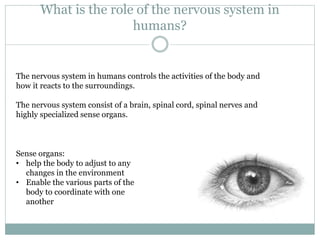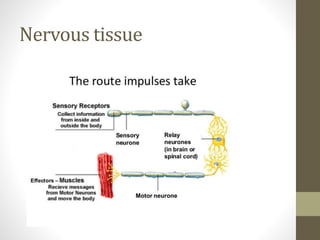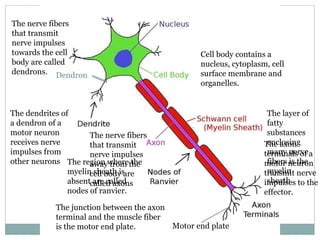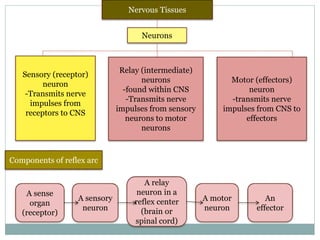IGCSE biology chapter 13- the nervous system
- 1. B Y : A D E L I N E L A U R E N C L A R I S S A G E R A L V I N M N O R A L I M J A S O N J A Y A L I E O W E N J O N G R U I Z O R L A N D O Biology Chapter 13 : The Nervous System
- 2. Sensitivity A living organism is able to react to changes in the surrounding. The change in the environment that cause an organism to react is called a stimulus. An organism’s reaction to a stimulus is called a response. The ability to respond to a stimulus is known as sensitivity or irritability.
- 3. An organism usually responds to a stimulus by moving in a way that benefits itself. For example: Plant needs light for photosynthesis, so they grow towards the light. This response occurs over time. Euglena, a single-celled organism, makes food by photosynthesis. Euglena swims towards the light. Cockroaches, move away from the light. They hide in dark areas during the day.
- 4. What is the role of the nervous system in humans? The nervous system in humans controls the activities of the body and how it reacts to the surroundings. The nervous system consist of a brain, spinal cord, spinal nerves and highly specialized sense organs. Sense organs: • help the body to adjust to any changes in the environment • Enable the various parts of the body to coordinate with one another
- 5. In humans, many activities such as the heartbeat, peristalsis and breathing movements are automatic and are not controlled consciously. They are called involuntary actions. Activities that are controlled consciously are called voluntary actions. Voluntary and involuntary actions
- 6. Thoughtless action Sea anemone are some of the simplest animals under the sea, they do not even have brains. When a prey such as small fish brush against a sea anemone’s tentacles, stinging cells in the tentacles are stimulated. The sea anemone responds by stinging the prey. This is called as involuntary action.
- 7. Human nervous system Component of the human nervous system: -The central nervous system (CNS) consisting of the brain and the spinal cord -The peripheral nervous system (PNS) consisting of the cranial nerves (nerves from the brain) and spinal nerves (nerves from the spinal cord) and the sense organs.
- 8. -Sense organs are used to detect stimuli, they are also called receptors. They inform the central nervous system about changes in the surroundings, by producing electrical messages called nerve impulses. These nerve impulses are transmitted through the peripheral nervous system to the central nervous system.
- 10. Motor end plate Dendron Cell body contains a nucleus, cytoplasm, cell surface membrane and organelles. The nerve fibers that transmit nerve impulses towards the cell body are called dendrons. The dendrites of a dendron of a motor neuron receives nerve impulses from other neurons The nerve fibers that transmit nerve impulses away from the cell body are called axons The layer of fatty substances enclosing many nerve fibers is the myelin sheath. The region where the myelin sheath is absent are called nodes of ranvier. The axon terminals of a motor neuron transmit nerve impulses to the effector. The junction between the axon terminal and the muscle fiber is the motor end plate.
- 11. Structure of sensory neurone Direction of nerve impulse
- 12. What is a synapse? Definition of synapse: A synapse is a junction between 2 neurones, or a junction between a neurone and an effector such as a muscle or a gland At a synapse, impulses are transmitted from the axon of one neurone to the dendron of another neuron ( or the cells of the effector) across the tiny space Nerve impulse are transmitted across the synapse by certain chemicals released by the neurone. These chemicals are called neurotransmitters
- 13. What are nerves? A nerve is a bundle of nerve fibres enclosed in a sheath of connective tissue. Nerve may emerge from the brain (cranial nerve) or spinal cord (spinal nerve). They may contain: • Sensory nerve only – conduct nerve impulses from sense organs. • Motor nerve fibres only – conduct nerve impulses from effectors. • Mixed fibres (both sensory and motor nerve fibres) – located in spinal nerves.
- 14. Brain Forebrain: • Concerned with intelligence, memory, learning sensations and overall control of all voluntary actions in human • Concerned with the regulation of body temperature and water potential of blood, appetite, sleep and emotions • Produces and relase many important The human brain can be divided into 3 parts: the forebrain, the midbrain, and the hindbrain Midbrain: •Concerne d with sight and visual reflexes, e.g. movement of the eyeballs Forebrain: • Controls muscular coordination, especially maintaining balance • Controls involuntary actions, e.g. the heartbeat, peristalsis, the rate of respiratory
- 15. Distribution of the grey matter and white matter in the central nervous system Grey matter The grey matter consist of mainly of the cell bodies of the neurones . It forms the outer layers of the brain and the central parts of spinal cord White matter The white matter consist of mainly of nerve fibres . It forms the central parts of the brain, and the outer layers of the spinal cord. Central canal The central canal contains a fluid called cerebrospinal fluid that brings nutrients to spinal cord
- 16. As the spinal nerves leave the spinal cord, it branches itself into nerve fibres which is supplied to different parts of our body • Before the spinal nerve joins the spinal cord, it is divided into two roots : a) Dorsal root ( towards the back ) b) Ventral root ( towards the front )
- 17. 1. Sensory neuron in the spinal cord transmit impulses to the relay neuron in the brain 2. Relay neuron in the brain transmit impulses back to the motor neuron in the spinal cord Remember ! The relay neurons synapse with the sensory and motor neurons to enable the transmission of nerve impulses from the sensory to motor neurons
- 18. Dorsal root ganglion • A small swelling in the dorsal root containing cell bodies of sensory neurons Dorsal root • Joints the back part of the spinal cord • It contains nerve fibres of sensory neurons that transmit impulses to the spinal cord Ventral root • Joins the front part of the spinal cord • It contains only nerve fibres of motor neurons that transmit impulses from the spinal cord Spinal nerve (mixed nerve) • Form by the joining of dorsal and ventral root • Contains both sensory and motor neurons
- 19. Sensation When you touch a piece of ice, you can feel its coldness. This is because the temperature receptor in in your skin is stimulated. Impulses are produced. Impulses are transmitted to the forebrain. The brain interprets the impulses, and you have a sensation of coldness. The pathway of impulses is as follows: Receptor in skin sensory neurone relay neurone in spinal cord forebrain
- 20. voluntary actions Voluntary action is a deliberate action, for example, you decide to raise your hand to answer a question in class. The pathway of impulses is as follow: Forebrain relay neurone in spinal cord motor neurone effector
- 21. Reflex Action Reflex action is an immediate response to a specific stimulus without conscious control It is an involuntary action Classified into : - Cranial reflexes - Spinal reflexes The spinal cord and the brain are reflex centres
- 22. Knee Jerk Reflex
- 24. Reflex arc A reflex arc is the shortest pathway by which nerve impulses travel from the receptor to the effector in a reflex action
- 26. The nervous system Central nervous system (CNS) Peripheral nervous system (PNS) Brain Spinal cord Receptors Nerves - Controls voluntary actions by generating nerve - Controls cranial reflexes e.g. salivation - transmit nerve impulses to and from brain - controls spinal reflexes .e.g. knee-jerk reflex Receive stimuli from the environment Cranial nerves -sensory nerves transmit impulses from receptors to the brain. -Motor nerves transmit impulses from brain to effectors Spinal nerves -sensory nerves transmit impulses from receptors to spinal cords . - Motor nerves transmit impulses from spinal cord to effectors
- 27. Nervous Tissues Neurons Sensory (receptor) neuron -Transmits nerve impulses from receptors to CNS Relay (intermediate) neurons -found within CNS -Transmits nerve impulses from sensory neurons to motor neurons Motor (effectors) neuron -transmits nerve impulses from CNS to effectors Components of reflex arc A sense organ (receptor) A sensory neuron A relay neuron in a reflex center (brain or spinal cord) A motor neuron An effector


























